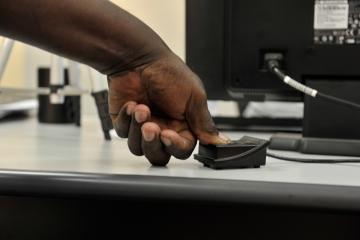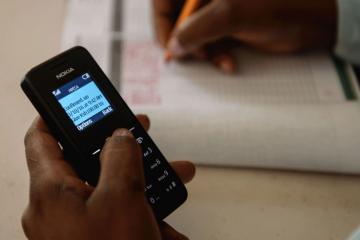
DigiFI blog series: Deepening our understanding of the digital ID and payment research agenda
As of December 2020, 215 countries or territories have planned or implemented a total of 1,414 social protection measures in response to the COVID-19 pandemic and resulting socio-economic difficulties. Digital technologies, such as mobile money and authentication via digital IDs and biometrics, are largely being used to facilitate these payments to limit the physical interaction between individuals and the spread of the virus.
For over a decade, following the rapid growth in internet access and mobile phone penetration, governments across sub-Saharan Africa have been investing in new ways of digitizing financial services and identification systems to improve service delivery and governance and reduce leakages in public programs.
Yet, we have limited rigorous evidence on the impacts of these reforms, particularly in sub-Saharan Africa. Theoretically, digital systems have the ability to transform individuals’ lives through improved identification and access to public services. However, there is also the potential for these reforms to exclude vulnerable individuals or violate citizens’ rights to privacy.
To fill this knowledge gap and better inform policy, the Digital Identification and Finance Initiative (DigiFI) in Africa generates rigorous evidence on the impacts of digital ID and payment systems on both governments and citizens in sub-Saharan Africa.
To unpack some of the interesting research and policy questions around digitization, DigiFI Africa launched a blog series in the last quarter of 2020. The series, which spanned the course of two months, included nine posts on different dimensions of DigiFI’s research agenda. Below are some key takeaways from the series.
Digital IDs could overcome barriers to identification and access, but we don’t know enough yet about potential drawbacks
An estimated 494 million people in sub-Saharan Africa have no form of legal identification. Digital IDs present a groundbreaking opportunity to overcome many of the problems of identification faced by African countries and their citizens. For instance, biometric ID systems may make it easier to implement and effectively target government programs, while enabling citizens to participate in the economy since biometric data can serve as a universally valid proof of identification.
However, these systems may lead to exclusion or the undermining of privacy. Despite the broad impacts that digital IDs can have, there is little research outside of India on how they can improve the implementation of welfare programs, how these systems and linked programs affect citizens, and what unintended consequences may result from having access to IDs and their associated technology.
Digitizing government-to-person (G2P) payments could reduce costs for beneficiaries and governments, but could also lead to exclusion and face pushback from middlemen
The digitization of G2P payments can occur at different stages of the payment chain: the selection of beneficiaries, management of payment systems through digitized high-frequency data collection, or money distribution, for example using mobile money or direct bank transfers.
Potential benefits and costs associated with digital G2P payments
For beneficiaries, the digitization of G2P payments could potentially reduce costs associated with the collection of social protection payments and improve access to financial products and services. However, digitization can potentially exacerbate existing problems that beneficiaries face, or create new ones. Exclusion, predatory systems that leverage lack of digital or financial literacy and privacy issues are among the top concerns regarding the digitization of G2P payments.
For governments, a reduction in costs is a strong motivator to implement digital payment channels. Manual cash payments can be costly to distribute and implementation costs could be reduced if there is a strong existing technological infrastructure in place. Furthermore, reduction in leakages and the ability to more effectively monitor the delivery process may have financial and political benefits, reinforcing citizen’s trust in government systems. . This also means that governments implementing a digitized G2P system, may face political-economy challenges. Politically connected agents, who benefit from the existing cash-based system, may lobby against and even succeed in subverting policy reforms when their discretionary benefits are threatened.
Mobile money improves household resilience and reduces poverty in the long run
A growing body of research is emerging with a consistent finding: households are able to better respond to unforeseen difficulties, such as a flood or a child falling ill, when they have access to mobile money. That is, when an unexpected negative event occurs, households with mobile money are able to rely on the easy and affordable transfer of money from family and friends even if they are living far away.
In the long run, mobile money has also been found to change the way individuals within households make decisions around their occupation.
Impacts of mobile money in Kenya
In Kenya, researchers estimated that approximately 185,000 women moved from agriculture to small-scale retail as a result of access to M-PESA. Furthermore, another study in Kenya found that access to mobile money increased per capita household consumption and savings, and therefore reduced the rate of poverty. The effects were largest in female-headed households, highlighting how impact can be amplified when technology is given to female household heads.
While mobile money holds promise, it is not without its challenges and risks. These include infrastructure challenges, operational risks, and regulatory challenges.
Digitization can help overcome key barriers to effective public service delivery through:
1. Improved targeting: When it comes to social assistance, the most vulnerable are often left behind. The benefits of social assistance programs are often targeted to the poorest people of the country but in reality, it’s difficult to design and implement programs to effectively find and enroll these beneficiaries.
Digital ID systems could potentially remediate the lack of accurate income data by improving record-keeping and generating reliable administrative datasets on individuals in the country. Digital financial services enable the documentation of individuals’ financial transactions that can be used to create indices for eligibility, and digital government-to-person (G2P) payments can further enrich datasets on beneficiaries.
2. Reduced leakages: Rapid technological innovation and increasing connectivity present new opportunities to fight corruption and leakages in social programs.
Digitization has the potential to cost-effectively reduce leakages by reducing officials’ discretion through improved monitoring and auditing; cutting out intermediaries by automating processes; improving payment infrastructure; and improving identification and authentication through the use of digital identification or biometrics.
Impact of digitization on corruption in India
For example, a study in India found that biometric identification cards not only discouraged local officials from engaging in corrupt behavior due to improved availability and accessibility of information but also improved last-mile service delivery and welfare outcomes for beneficiaries. This resulted in beneficiary time savings equivalent to US$4.5 million (the government’s cost of program implementation and operation was US$4 million). Further, the estimated workfare program leakage reduction was US$38.5 million/year, nine times greater than the cost of implementing the new payment system.
3. Aligning incentives: Digitization can improve the delivery of incentives.
For public sector workers who live in remote areas, the ability to receive money directly through mobile money wallets could decrease the time lost due to travel and waiting in queues. Furthermore, digital IDs allow for work to be tracked in a more precise manner, for the allocation of incentives to be more accurately measured, and for benefits to be disbursed more predictably. Research shows that these improved payment methods could have a positive effect on incentivizing employees.
Digital systems using biometrics, GPS, and phone-based tracking could also be used to uniquely identify, accurately authenticate, and monitor public sector employees at the workplace.
4. Increased take-up of social programs: Digital technology could improve the take-up rates of social programs by improving beneficiaries’ experience, through a reduction in costs, administrative barriers, and an increase in possible benefits for the household.
In addition, digitization allows for the possible improved communication with beneficiaries, giving them more accurate and potentially targeted information about program benefits, and may be designed to reduce behavioral barriers such as procrastination.
If the digital system improves implementation and beneficiary experience, there could be an increase in trust in the system. However, malfunctioning technology could backfire and reduce trust in institutions leading to adverse outcomes.
5. Better access to high-frequency data and monitoring systems: Digitization allows for the quick collection and transfer of large amounts of data at relatively lost costs. This real-time data collection allows for monitoring and quick analysis that could help public sector institutions make decisions.
Monitoring systems: A tool for researchers to support government decision making
As a complement to longer-term evaluative research, monitoring systems can be an important way to support government decision making which often has short time frames. Possible outcomes could include tracking delivery, reach, and/or take-up of an intervention. Data collected through monitoring systems can be used as a stepping stone in building lasting relationships and co-generating evidence between researchers and policymakers. DigiFI encourages researchers to collaborate with governments to develop high-frequency process monitoring systems within digital identity and/or digital social payment systems.
Digital technology could help create a more gender-equal society
The private nature of digital payments, as opposed to cash, could help women maintain or assert control over their funds and income. Results from a 2016 study in Niger found that paying the transfer directly into the mobile wallets of women, as opposed to providing them cash, affected the distribution of intra-household bargaining power. More specifically, by making it more difficult for their spouse to observe the arrival of the transfer, digital social transfer programs provided women with more decision making power around how the transfer is spent.
Furthermore, financial inclusion can reduce poverty, particularly among women. In Kenya, researchers observed that the use of mobile money led to a 2 percent reduction in poverty. The impact on female-headed households was more than twice the average measured.
However, one needs to be cautious when implementing digital solutions to ensure that they do not lead to further division; especially since women’s access to and use of digital technology tends to lag in comparison to men.
Looking forward
To date, DigiFI Africa has funded a number of full randomized evaluations, pilots, and proposal development grants covering various aspects of digital payments and digital identification, increasing the knowledge base around these reforms. Read more about DigiFI Africa’s ongoing projects.
DigiFI Africa is supporting more evidence generation and implementation on the continent
If you are a policymaker interested in understanding how to design and implement digital payments or identification systems in your country, or a stakeholder interested in this field of study, please reach out to the DigiFI Africa team.




